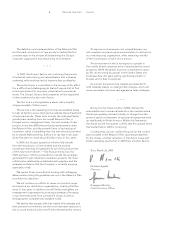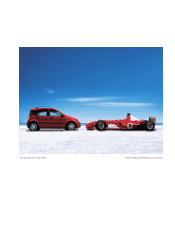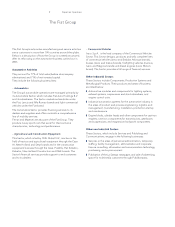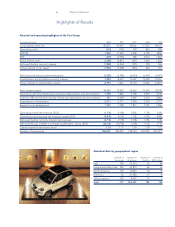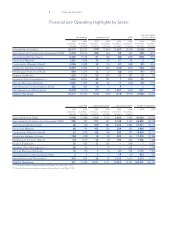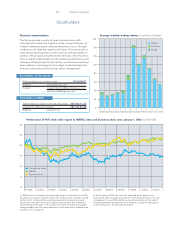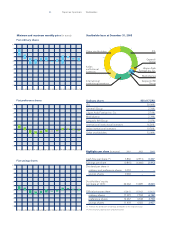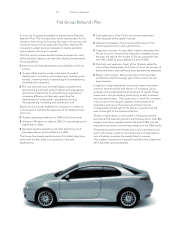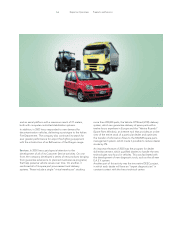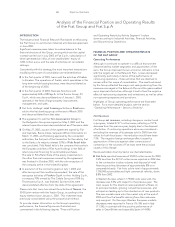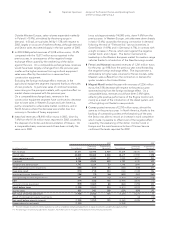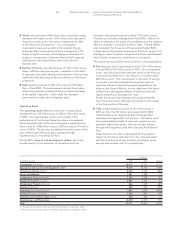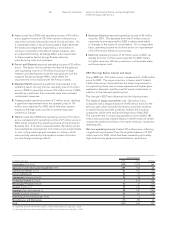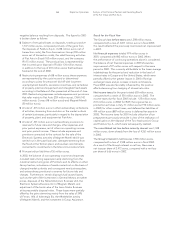Chrysler 2003 Annual Report Download - page 16
Download and view the complete annual report
Please find page 16 of the 2003 Chrysler annual report below. You can navigate through the pages in the report by either clicking on the pages listed below, or by using the keyword search tool below to find specific information within the annual report.
15 Report on Operations
Overall, approximately 13,000 people at 109 centers in Italy
and abroad worked on the Group’s research and development
projects in 2003. Total R&D expenditures came to 1,747 million
euros, or 4% of manufacturing revenues.
Efforts continued during the year to strengthen and rationalize
the Group companies’ pursuit of innovation. In particular,
cooperation between the Fiat Research Center (FRC) and Elasis
was more intense than ever, ensuring that the two research
facilities can interact more effectively and achieve a greater
degree of synergy. This commitment led to several projects
to which each center contributes its own unique skills.
Fiat Research Center
In 2003, the Fiat Research Center and its staff of around 950
employees achieved results which had a significant impact on
product and process innovation, helping improve the Group
companies’ industrial competitiveness.
Thanks to its research, the FRC transferred over 250 deliverables
to clients during the year and earned a number of awards,
including:
❚The award received at the 32nd Barcelona International Motor
Show for the Center’s highly innovative UNIAIR electronic
valve control technology.
❚The “Oscar Masi” award for industrial innovation assigned
to the “Gasdriver” vehicle. This vehicle, which combines a
robotized transmission, natural gas-powered engine and
an electric motor/generator, was voted best product in the
“Energy technologies for sustainable development” category.
Scientific output was particularly prolific, as witnessed by the 97
patents filed during the year. With these additions, the number
of active patents held by the Fiat Research Center rose to 891.
The major achievements of 2003 are reviewed below:
❚90 HP 1.3-liter 16-valve diesel engine. The Fiat Research
Center contributed to the development of a new version
of the small Multijet diesel powerplant which was specifically
designed to increase maximum torque by 17% and power
output by 28%, all while complying with the future Euro 4
emissions limits. The new engine will be taken into
consideration for future applications on mid-size and small
cars of the Fiat Group.
❚Fiat Seicento Hydrogen. The second version of the hydrogen-
powered Seicento was developed with fundings from the
Italian Ministry of the Environment. Road tests on the vehicle
confirmed the new fuel cell propulsion system’s high
efficiency.
❚Infonebbia fog warning system. The Fiat Research Center
and ANAS, the Italian national highway administration,
promoted the “Integrated Traffic Safety” project based
on cooperation between smart vehicles and highways. This
project will set up two development test sites equipped
with Intelligent Transportation Systems (ITS) and a mini-fleet
of vehicles. The objective: help the driver, prevent traffic
accidents resulting from fog and, if they occur, minimize their
consequences. In critical situations, “Safety Cars” equipped
with innovative systems will guide the other vehicles at a safe
speed.
❚LED taillamp technology. The Fiat Research Center
demonstrated the feasibility of its patented LED (Light
Emitting Diode) technology by developing a 7 mm thick
taillamp unit that is expected to offer a number of advantages
over conventional components, including minimum thickness,
low cost for both the device and for the system as a whole,
and greater design freedom.
❚Diesel particulate filter. Using DPFs, or Diesel Particulate
Filters, brings particulate emissions of diesel engines to levels
similar to those of their spark ignition counterparts. Together
with Fiat-GM Powertrain, the Fiat Research Center has
developed a filter system that, unlike the designs currently
in use, requires no maintentance or additives, and makes full
use of the MultiJet powerplant’s potential.
Elasis
Elasis, with a staff of more than 800 employees, operates in
the field of research on automotive products and processes,
and is provided with sophisticated testing equipment and
computer-aided design tools. It is thus a basic asset for a
Group pursuing a strategy of continuous innovation.
Being able to participate in projects enjoying national or EU
funding (where 16 grant applications representing a total value
of 83 million euros were submitted in 2003) helps Elasis
cooperate with the public research system. It also stimulates
the development of the basic knowledge which is essential
for effective applied research.
In this context, Elasis takes part in the initiatives sponsored and
approved by the Italian Ministry of Education, Universities and
Research. In 2003, Elasis thus joined with the Ministry and the
Campania regional administration in setting up the Naples
Materials Science Center (Distretto Tecnologico sui Materiali).
Exploiting its know-how and ability to integrate design,
experimentation, and technological skills, Elasis is developing
a new concept of highly versatile automobile.
In 2003, Elasis continued to develop methods for extending
its Virtual Product Development (VDP) capabilities. Among
significant achievements, Elasis simulated all of the crash tests
called for by current European regulatory requirements, and
developed a virtual reality facility where researchers can go
through all the motions of disassembling a car.
For its work on vehicles, Elasis is investigating innovative
architectures that will serve as the building blocks for new
products with versatile interior layouts, all-wheel drive systems,
modular chassis frames and highly accessible body shells.
In powerplant design, Elasis continued to expand the know-how
it can bring to bear on small-displacement spark ignition
engines, reducing their fuel consumption and exhaust
emissions. In particular, introducing innovations such as the
Innovation and Technology


